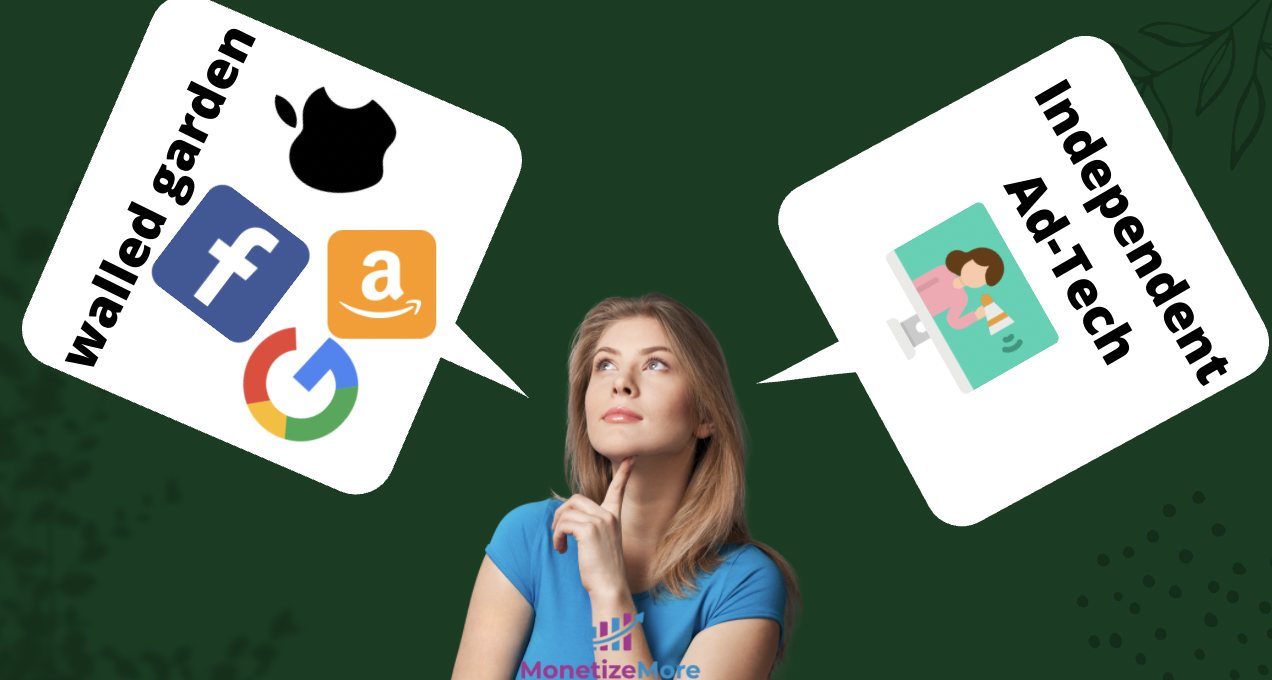Walled garden advertising offers publishers the ability to own their audience data and maximize ad revenue. While the term might seem technical, the concept is simple: publishers are building their own exclusive spaces online, much like a private garden with a high wall.
By creating a closed environment, publishers can offer advertisers a more targeted and engaged audience, leading to better campaign performance. This shift has major implications for how advertisers reach their target audience. Discover how this strategy can make your site more profitable below:
What are walled gardens?
A walled garden is a system where tech platforms control your content, media, and applications.
With this control, third-party applications and content, such as your audience data, are restricted from being accessed and monetized.
As a publisher who uses walled gardens, you gain massive audience reach, monetization benefits, and traffic-boosting opportunities.
A majority of major walled gardens are Facebook, Twitter, Snapchat who built their initial ad technology offering in-house to meet their own needs.
Their approach combines their services as a publisher with those of an ad-tech provider.
This is unlike the Open Internet, which typically involves publishers having control over their media and data being added, removed, or modified.
Within digital publishing, providers like GAFA—Google, Apple, Facebook, and Amazon—are the main walled gardens, while providers like AppNexus, Index Exchange, and TripleLift belong to the Open Internet category.
Let’s explore how walled gardens operate in the AdTech business, their pros and cons, and their impact on publishers.
Why are publishers increasingly turning towards Walled Gardens?
Publishers are increasingly turning towards walled garden advertising due to a confluence of factors reshaping the digital advertising landscape:
- Data Privacy Concerns and Regulations: With growing consumer awareness of data privacy and regulations like GDPR and CCPA, publishers face challenges in relying on third-party cookies for ad targeting. Walled gardens allow them to collect and leverage valuable first-party data in a privacy-compliant way, building direct relationships with their audience and offering personalized experiences.
- Reclaiming Control and Revenue: In the open programmatic ecosystem, publishers often cede control over their ad inventory and revenue to intermediaries. Walled gardens empower publishers to set their own rules, negotiate directly with advertisers, and potentially achieve higher CPMs (cost per thousand impressions) by offering a more premium and controlled environment.
- Combatting Ad Fraud and Brand Safety Issues: The open web is susceptible to ad fraud and brand safety risks, which can erode advertiser trust and revenue. Walled gardens provide a more secure and transparent environment, minimizing these risks and offering advertisers greater confidence in their campaigns.
- Direct User Relationships and Engagement: Walled gardens enable publishers to foster deeper relationships with their audience through personalized content, exclusive offerings, and loyalty programs. This increased engagement can lead to higher user retention and subscription revenue.
- Diversifying Revenue Streams: Relying solely on programmatic advertising can be volatile. Walled gardens allow publishers to diversify their revenue streams by offering various ad formats, direct deals, and subscription models within their controlled environment.
- Competition with Tech Giants: Publishers are facing increasing competition from walled gardens like Google and Facebook. To level the playing field and retain control over their audience and data, they are adopting similar strategies.
Walled Garden Advertising: Pros & Cons
Walled gardens lead to monopolies that burn the competition and generate an unstable power dynamic, though they can also be strangely effective tools for publishers.
Here’s the good, the bad, and the ugly.
The Good
User Security: Companies such as Apple pride themselves on their walled gardens. Sometimes, advertisers are even required to obtain user consent to make certain tracking options available. All data is encoded so that none can be shared with third parties. Within a closed platform, the service provider controls the data and can implement effective security measures to protect it.
Cross-Device Targeting: Most users use their mobile phones, tablets, or laptops for a quick Google search or Amazon Add to Cart. All these actions do not happen on a single device (Duhh!). In turn, these platforms have access to cross-device data that can be shared with advertisers and reach into users’ lives regardless of the devices they are streaming on.
Rich User Data: The GAFA walled gardens have abundant user data that can be leveraged to build further targeted campaigns that lead to profitable yield for both the advertisers and publishers and potentially offer users more of what they came for.
The Bad
- Data usage is confined to the platform, and restricted activation elsewhere, resulting in data silos.
- Fragmented reporting and restricted exports to other systems
- Different solutions demand to cover additional channels, leading to time & cost-intensive vendor governance
- Closed ecosystem: Burdening integrations to other solutions in the AdTech industry
You can try building your walled garden, but in the AdTech world specifically, taking the path of least resistance means going where the people are, and there are billions already in the walled gardens of GAFA.
The GAFA walled gardens are not your competition, but these ecosystems can take your ad inventory game to another level if you use them properly.
Walled Gardens vs. Independent Ad-Tech Companies
Google, Facebook, and Amazon may account for more than half of all revenue generated from digital advertising, but they’re not the only players.
Independent AdTech companies are the entities outside the walled gardens.
These include:
- Demand-side platforms (DSPs)
- Supply-side platforms (SSPs)
- Ad networks
- Ad exchanges
- Ad servers
- Consent management platforms (CMPs)
- Data management platforms (DMPs)
- Identity resolution vendors
- Ad quality vendors: LiveRamp, Magnite, MediaMath, The Trade Desk, OpenX, etc., are a few examples of independent AdTech companies.
Although independent ad tech companies lack the scale and data of the Triopoly, they offer brands, advertisers, agencies, and publishers an array of benefits:
- Better support: Ad tech companies, mainly oriented towards growth and retention, tend to provide direct access to help and tech support, assigning committed account managers to most clients. Getting instant one-on-one support from GAFA is difficult unless you’re a prioritized client.
- Customization: You can easily work with independent ad technology vendors to develop custom solutions or build your own using their open application programming interfaces (APIs). With walled gardens, you get the same solution with minimal scope of customization, regardless of size.
- Data Ownership: For header bidding, most independent ad tech vendors allow their clients to upload their own data sets for targeting, and publishers usually have access to log-level data. On the other hand, walled gardens are more restrictive in terms of the data that can be ingested into or gleaned from them.
- Transparency: With independent AdTech companies, you can access reporting data, metrics, and attribution more freely than walled gardens, which pose as black boxes. Independent ad tech companies provide access to measurement, attribution, and reporting data more freely than walled gardens, which tend to operate as black boxes. Furthermore, they often allow 3rd-party companies to regularly verify, measure, and integrate ad campaigns and revenue performance.
How do walled gardens impact publishers?
Publishers are in a solid position to develop their walled garden versions since they have stacked up all the data and user logs. (User data is collected each time a visitor logs on to view your blog)
Increasingly scarce consumer data could result in price increases as well.
Therefore, publishers seek to expand their addressable audiences through legit registration strategies.
Google and Facebook have abundant data about consumer purchases, but they cannot provide value in the form of rich content like publishers.
This means these platforms cannot collect user metrics about how people engage with content.
Media agencies also see this as a gold mine in tapping into the publisher-backed walled gardens.
The media agencies see their companies as navigators in this complicated ecosystem, and investments are necessary to optimize data distributed among the many walled gardens—small and medium-walled gardens are included in these cases, too.
Regarding improving the yield for every impression, competition on the demand side directly benefits publishers.
This is the main reason why our header bidding solutions have been gaining widespread adoption, which also serves as a solid illustration of how walled gardens impact publishers.
Before header bidding, Google handed the ad exchange (Google AdX) a “last-look” advantage.
As a result, AdX could review all competing bids before an impression was served and then outbid them. Meanwhile, the less popular exchanges didn’t get the opportunity to do the same.
All exchanges could bid on every impression simultaneously through header bidding, resulting in a higher yield for publishers.
After header bidding was already mainstream, Google revoked AdX’s “last-look” advantage.
Publishers with large first-party datasets often create their walled gardens, offering certain users ad-supported content while others can subscribe.
A publisher’s best defense against walled gardens is to better understand their audience, work with demand-agnostic ad tech partners, and package their ad inventory or ad space in ways that advertisers find appealing.
Wrap Up

| Walled Garden Advertising Benefits | Walled Garden Advertising Challenges |
|---|---|
| Data Ownership and Control: Direct access to first-party data for better audience understanding, content personalization, and targeted advertising. | Limited Reach: Smaller audience compared to the open web, potentially impacting revenue for publishers reliant on scale. |
| Increased Revenue Potential: Higher CPMs, direct deals, and alternative revenue streams (subscriptions) are possible. | Technology Investment: Significant investment in technology and infrastructure is required to build and maintain it. |
| Enhanced User Experience: Greater control enables a more engaging and user-friendly environment for increased loyalty and retention. | Attracting Advertisers: Convincing advertisers of the walled garden’s value and attracting them to a potentially smaller, niche audience. |
| Brand Safety and Ad Fraud Reduction: A closed ecosystem minimizes risks for both users and advertisers by reducing fraud and inappropriate content. | Balancing Control with User Experience: Overly restrictive environments can negatively impact user experience and engagement. |
So, what is our ultimate advice for publishers? Pick an open, well-integrated platform that allows seamless access to leading ad networks.
With MonetizeMore, our commitment to openness stretches beyond our products. We dedicate significant time and resources to ensuring that integration partners can access us.
This open approach makes facilitating these integrations a core part of our offering and ensures publishers have the upper hand in any situation.
Open up and showcase your ad inventory!
source https://www.monetizemore.com/blog/wait-what-publishers-are-building-their-own-walled-gardens-now/




0 Comments